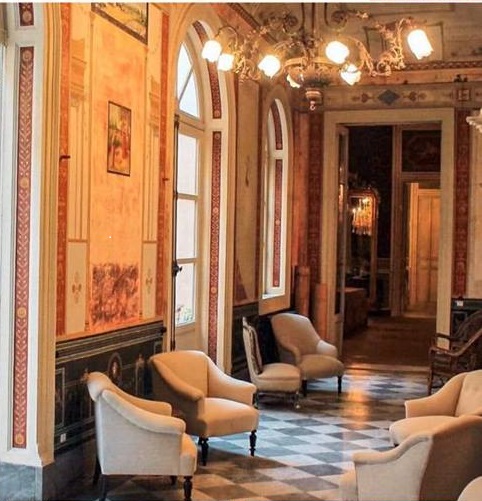Read
English version
Alle spalle della sontuosa Cattedrale di Palermo, sul lato settentrionale di Piazzetta Sett’angeli sorge il sobrio ed elegante Palazzo del Marchese Artale, una nobile dimora resa dagli attuali proprietari finalmente accessibile alle visite culturali e turistiche, dopo un lungo periodo in cui l’intero palazzo è stato oggetto di una importante campagna di restauro conservativo. L’edificio, a cui si accede da un ampio portone, nel Settecento fu edificato fino al primo piano dai primi proprietari, gli Artale, poi nella seconda metà dellOttocento venne completato con una seconda elevazione e la copertura dall’ultimo proprietario, il Barone Tumminello, che lo acquistò precisamente nel 1878. L’immobile comprendeva più fabbriche ed anche una chiesetta, poi demolita ed inglobata nella struttura, che si sviluppavano per un lungo tratto della salita Artale, dove il palazzo ha mantenuto un altro ingresso con ampio giardino, una corte interna e la torre dellacqua. Oggi il Palazzo è conosciuto come Artale Tumminello.

Quando, alla fine del XVIII sec. il Palazzo era sotto la proprietà di Giuseppe Artale Procobelli , Marchese di Collalto, alcune sale del Piano Nobile furono elegantemente decorate in stile neoclassico dagli artisti Giuseppe Renda e Francesco La Farina. Questultimo, allievo del pittore Giuseppe Velasco, mise in pratica nellesecuzione dell’opera, i suoi stessi modelli stilistici e iconografici. Gli episodi illustrati si rifanno alla mitologia greca e si riferiscono alle scene più toccanti della guerra di Troia. Negli undici saloni visitabili e risanati dopo il restauro conservativo di quasi 8 anni, sono ancora oggi custoditi dipinti ed affreschi, arredi originali, mobili e oggetti dell’artigianato locale, e l’atmosfera ricreata è quella di un ambiente familiare e quotidiano della nobiltà sette-ottocentesca. Non manca infine il Salone delle Feste ed un rigoglioso giardino d’inverno. A Palazzo Artale Tumminello potrete scoprire il fascino, oltre delle sale o dell’alcova del marchese, anche di certi passaggi segreti o piccoli stanzini che usava la servitù per spostarsi velocemente tra i saloni e infine godere, dai suoi balconi, di una inusuale e straordinaria vista sull’abside arabo-normanna della Cattedrale di Palermo.
Descrizione e foto sono state inviate dall’associazione Cultura Iiner’ars
*ENGLISH
Behind the magnificent Cathedral of Palermo, on the northern side of Piazzetta Sett’Angeli, stands the sober and elegant Palace of the Marquis Artale, a noble residence. Finally the current owners made it accessible to cultural and tourist visits, after a long period in which the Palace was the subject of an important conservative restoration campaign. The building, which is accessed by a large door, was built up to the first floor in the 18th century by the first owners, the Artales, then in the second half of the nineteenth century it was completed with a second elevation by the last owner, Barone Tumminello, who bought it precisely in 1878. The building included several structures and even a small church, which was later demolished and built in the Palace. They developed along a stretch of Salita Artale, where the building maintained another entrance with a large garden, an inner courtyard and the water tower. Today the Palace is known as Artale Tumminello.
When, at the end of the 18th century the Palace was under the ownership of Giuseppe Artale Procobelli, Marquis of Collalto, some rooms of the Piano Nobile were elegantly decorated in neoclassical style by the artists Giuseppe Renda and Francesco La Farina. The latter, a pupil of the painter Giuseppe Velasco, put his own stylistic and iconographic models into practice in the execution of the work. The illustrated episodes take inspiration from Greek mythology and refer to the most touching scenes of the Trojan war. In the eleven renewed salons, that can be visited after the conservative restoration of almost 8 years, paintings and frescoes, original furnishings, furniture and objects of local craftsmanship are still preserved today, and the recreated atmosphere is that of a familiar and everyday environment of the eighteenth and nineteenth century nobility. Finally, there is the Salone delle Feste and a luxuriant winter garden. At Palazzo Artale Tumminello, besides the halls and the Marquiss alcove, you can also discover the charm of certain secret passages or small rooms, used by the servants to move quickly between the salons. At the end of the tour you will enjoy an unusual and extraordinary view of the Arab-Norman apse of the Cathedral of Palermo.
Description and photos have been sent by the Iiner’ars Culture association. Website: www.palazzoartaletumminello.com


